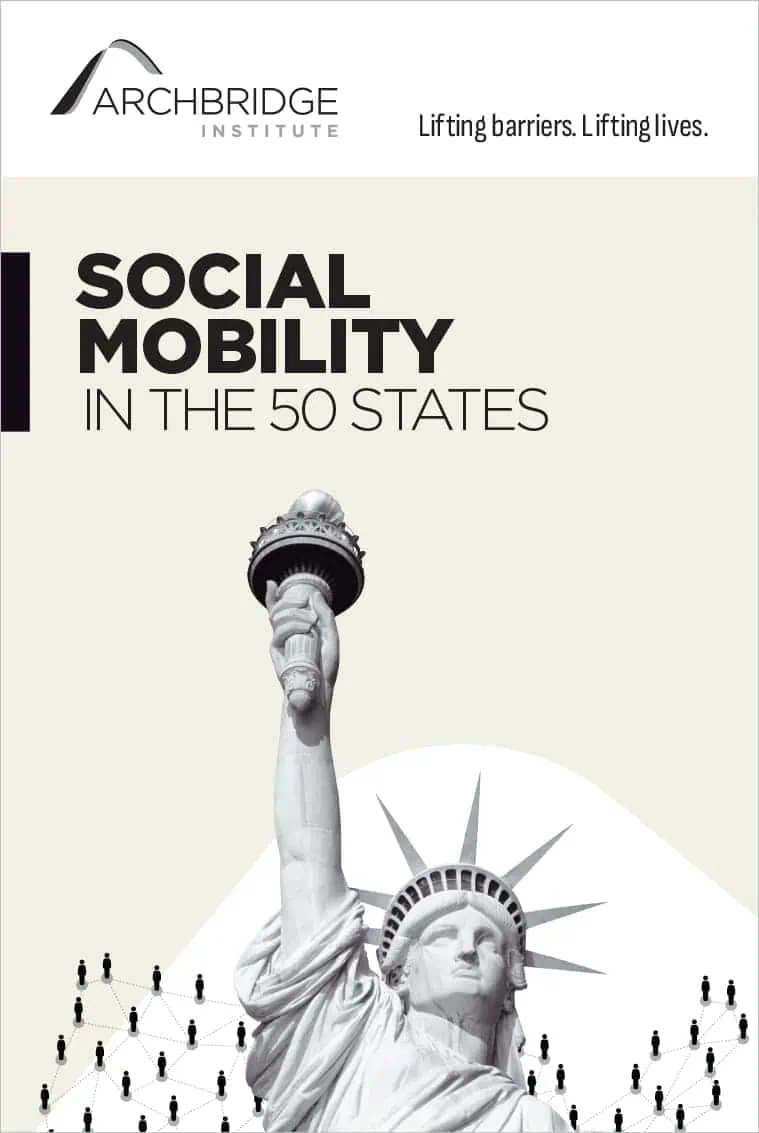
EXECUTIVE SUMMARY
Economic mobility has become a leading policy concern across the political spectrum in America. But “opportunity” and “mobility” are elusive concepts. Without clearheaded thinking about what they mean and how to measure a particular way of viewing opportunity, it is easy to misinterpret the evidence on economic mobility. Further, getting a handle on the evidence itself is no easy task. The present report is the first in a series that, together, will constitute a state-of-the-art primer on intergenerational economic mobility in the United States. The need for such a primer is not only evident from the explosion of mobility research in recent years that has scrambled our understanding of the topic. Less understood is the need to clear up rampant confusion over what different mobility measures actually measure. The report provides an overview of the different ways of measuring both relative and absolute mobility (i.e., movement in ranks and movement in dollars). It distinguishes between mobility indicators that assess movement in different parts of the parental and child income distributions, as well as summary measures that describe how mobility does or does not reduce childhood inequalities. Using a survey that has recorded information on thousands of families for nearly fifty years—following children as they leave home and establish their own households—the report presents new state-of-the-art estimates of an unprecedented range of economic mobility measures. The estimates constitute the most comprehensive suite of mobility measures that anyone has produced. The report also discusses the strengths and weaknesses of summary measures in assessing the extent of equal opportunity. An upto-the-minute literature review on levels of American economic mobility is included in an appendix.
Among the highlights of this report:
- Consistent with past research, the report documents the strong odds that poor children will fare no better relative to their peers than their parents did. Nearly half of children with parents in the bottom fifth of family income end up in the bottom fifth as well. Children who grow up with the richest parents are only somewhat less immobile.
- These estimates are based on averaging family incomes over 9 to 15 years within a window of up to 31 years. If they could be averaged over entire careers, immobility would look even stronger.
- Nevertheless, roughly three in four adults—and the overwhelming majority of poor children—live better off than their parents after taking the rising cost of living into account. This rate is higher than in the headline findings of a recent wellpublicized paper by Stanford University economist Raj Chetty and his colleagues. This report shows that Chetty et al.’s results can be replicated with survey data but illustrates why the headline finding paints too dour a picture of mobility.
- The report shows, for the first time, tables that illustrate the likelihood poor and well-to-do adults will have a same-sex sibling who is also poor or well-to-do. The family incomes of siblings do not strongly resemble each other, except at the bottom and top. Among adults in the bottom fifth of income who have a samesex sibling, over 40 percent of the time that sibling is also in the bottom fifth. The family incomes of siblings at the top are nearly as similar.
- Sibling similarity is especially strong for brothers’ earnings.
- The report includes innovative illustrations of how sensitive summary measures of economic persistence are to the number of years of income averaged and to restrictions on how many years are required in order to be included. Estimates for over 200 samples were produced for each summary indicator in the report, with preferred ranges and point estimates reported for each.
- Relative mobility reduces percentile gaps between children by about 35 to 55 percent for the earnings of men, by 55 to 70 percent for the earnings of women, and by 45 to 50 percent for family income. The “income rank association,” on which these estimates are based, reflects the high degree of mobility within the broad middle of the income distribution but masks the “stickiness at the ends” found earlier in the report.
- The income rank associations estimated here—on the order of 0.45 to 0.65 for men’s earnings, 0.30 to 0.45 for women’s earnings, and 0.50 to 0.55 for family income—are higher than in almost all previous studies. They improve on those earlier studies by averaging up to 15 years of income within a window of up to 31 years, centered on age 40, when incomes most closely resemble lifetime income.
- The report explains why the most popular mobility estimate—the “intergenerational elasticity,” or IGE—summarizes absolute mobility rather than relative mobility, contrary to the conventional wisdom among mobility researchers.
- IGE estimates have become increasingly large as research methods have improved, indicating a smaller reduction of childhood income gaps by adulthood than previously believed. Nevertheless, this report concludes that nearly all previous estimates are too low, overstating the extent to which childhood income gaps are diminished in adulthood. The report estimates IGEs of between 0.70 and 0.80 for male earnings, 0.35-0.55 for female earnings, and 0.65-0.75 for family income. It also speculates that they could be higher. Roughly, at an IGE of 0.75, the future grandchild of an adolescent growing up with twice the income of his classmate will still have an income 34 percent higher than his classmate’s grandchild.
- The report summarizes very recent critiques of Gregory Clark’s The Son Also Rises, which claimed that mobility is remarkably low and consistently so across nations and eras.
- It includes sibling rank association estimates—only the second time such estimates have been presented, to my knowledge. The relative earnings gap between the brother of a higher-earning man and the brother of a lower-earning man will tend to be 40 percent as large as the gap between those two men. The gap between the sister of a higher-earning woman and the sister of a lowerearning woman will tend to be 30 percent as large as the gap between those two women. This narrowing of relative gaps obscures the greater similarity between poor siblings and rich siblings, however.
- Conventional sibling correlations are also estimated, and the report demonstrates that averaged income data can yield correlations as large as those produced from complicated modeling of the evolution of “permanent” and “transitory” income.
- The sibling correlations indicate that nearly half of female earnings inequality occurs between sisters within the same family, while roughly 30 to 35 percent of male earnings inequality and of family income inequality occurs within families.
- The report explains why the intergenerational rank association is a better indicator of equality of opportunity than the intergenerational elasticity or correlation. The sibling rank association may be the best indicator of all, among summary measures.
- The literature review covers studies completed as recently as December 2016 and several forthcoming journal articles.
The primer will include two more installments—one on cross-national differences in economic mobility and another on trends in mobility in the United States.
Contemporary levels of mobility digital version_WinshipScott Winship, PhD, is a senior fellow and director of the Center on Opportunity and Social Mobility at the American Enterprise Institute. He serves as an academic advisor for the Archbridge Institute. Follow his work @swinshi.





